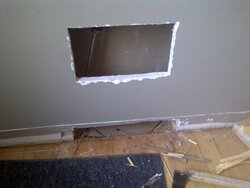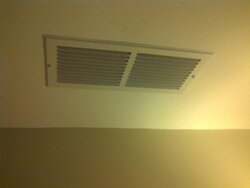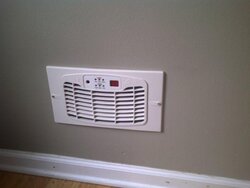I have my Englander 30 in the basement of my house. It's a one story ranch -- heats my place just fine. When I originally installed the stove, the basement was unfinished (concrete floors, block walls and exposed floor joists). I have since finished the basement (studded and insulated walls, drywalled ceiling and nature stone floors). I have noticed that the heat doesn't transfer to the upstairs as easily as it did before. It still gets warms upstairs -- just takes longer.
Bought a fan assisted register cover the other day to help move the heat from the basement to the upstairs. Decided that I wanted to install it on the wall upstairs as opposed to cutting into the hardwood floors and installing as a floor register.
Started by removing the baseboard and then cutting a square in the wall to install the register. I then cut a small access hole behind the baseboard to be able to get my sawzall in to cut the 2X4 bottom plate. Got the bottom plate cut out and then went to the basement to cut the square for the return cover. From below, I was able to cut the subfloor with my sawzall. I then installed the return cover on the ceiling in the basement and installed the register fan in the wall.
All in all it was a pretty straightforward and simple install. Only bled once (which makes it an official home improvement project) and it took me about 2-3 hours from start to finish. I just need to slap some paint on the baseboard where I had to nail it back to the wall.
And the best news -- it really does do a great job of pulling the heat upstairs. It's better than when the basement was unfinished.
Here'a link to the unit that I got -- http://www.rewci.com/ultra-register-booster-fan.html -- it was less than $65.00 and it has a thermostat and little wireless remote.
I attached some pictures of the during and after.
Bought a fan assisted register cover the other day to help move the heat from the basement to the upstairs. Decided that I wanted to install it on the wall upstairs as opposed to cutting into the hardwood floors and installing as a floor register.
Started by removing the baseboard and then cutting a square in the wall to install the register. I then cut a small access hole behind the baseboard to be able to get my sawzall in to cut the 2X4 bottom plate. Got the bottom plate cut out and then went to the basement to cut the square for the return cover. From below, I was able to cut the subfloor with my sawzall. I then installed the return cover on the ceiling in the basement and installed the register fan in the wall.
All in all it was a pretty straightforward and simple install. Only bled once (which makes it an official home improvement project) and it took me about 2-3 hours from start to finish. I just need to slap some paint on the baseboard where I had to nail it back to the wall.
And the best news -- it really does do a great job of pulling the heat upstairs. It's better than when the basement was unfinished.
Here'a link to the unit that I got -- http://www.rewci.com/ultra-register-booster-fan.html -- it was less than $65.00 and it has a thermostat and little wireless remote.
I attached some pictures of the during and after.





